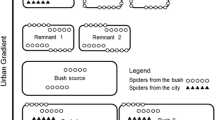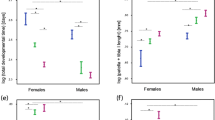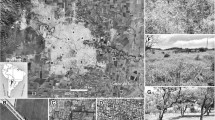Abstract
Urbanization can compromise biodiversity as cities expand further into native landscapes. The urban heat island (UHI) describes elevated urban temperatures due to heat retained by built structures (e.g. concrete surfaces). Animal behavior may be critical in determining an animal’s ability to thrive in the wake of human disturbance. Yet, we have a relatively poor understanding of how animal behavior is affected by the UHI. We examined sibling cannibalism in urban and desert juvenile black widow spiderling (Latrodectus hesperus) lineages exposed to extreme UHI temperatures (33 °C) or native Sonoran desert temperatures (27 °C). Family of origin had a significant impact on cannibalism, while the effects of temperature and habitat were dependent on spiderling density. Our most pronounced results came at the lower densities of three and two spiderlings. Here habitat and temperature interacted such that spiderlings at 33 °C were consistently more cannibalistic than spiderlings at 27 °C, and this result was consistently stronger for spiderlings from urban families than it was for spiders from desert families. If UHI-induced siblicide promotes the survival and growth of a subset of spiderlings from a clutch, then it might actually foster urban population growth. In contrast, if siblicide in the city simply reduces clutch size, then we might expect the UHI to slow urban infestations. Understanding behavioral phenotypes underlying the explosive population growth of urban pest species will aid in the development of safer and more effective deterrents to infestations, and allow us to better understand the mechanisms shaping urban biodiversity patterns.

Similar content being viewed by others
Availability of data
Data will be made publicly available on the CAP-LTER website.
Code availability
Code will be made publicly available on the CAP-LTER website.
References
Anderson JF (1970) Metabolic Rates of Spiders. Comp Biochem Physiol 33:51–72
Anthony CD (2003) Kinship Influences Cannibalism in the Wolf Spider, Pardosa milvina. J Insect Behavior 16:23–36. https://doi.org/10.1023/A:1022893127216
Bates D, Maechler M, Bolker B, Walker S (2015) Fitting Linear Mixed-Effects Models Using lme4. J Stat Softw 67(1):1–48. https://doi.org/10.18637/jss.v067.i01
Claessen D, De Roos AM, Persson L (2004) Population dynamic theory of sizedependent cannibalism. Proceedings of the Royal Society of London. Series B: Bio Sci 271(1537), pp.333–340
Diamond SE, Chick L, Perez A, Strickler SA, Martin RA (2017) Rapid evolution of ant thermal tolerance across an urban-rural temperature cline. Biol J Linn Soc Lond 121:248–257
Diamond SE, Martin RA (2020) Evolutionary consequences of the urban heat island. In: Szulkin M, Munshi-South J, Charmantier A (eds) Urban Evolutionary Biology. Oxford University Press
Ditchkoff SS, Saalfeld ST, Gibson CJ (2006) Animal behavior in urban ecosystems: Modifications due to human-induced stress. Urban Ecosyst 9(1):5–12
Doering GN, Scharf I, Moeller HV, Pruitt JN (2018) Social tipping points in animal societies in response to heat stress. Nat Ecol Evol 2(8):1298–1305
Donihue CM, Lambert MR (2015) Adaptive evolution in urban ecosystems. Ambio 44(3):194–203
Fisher AM, Cornell SJ, Holwell GI, Price TA (2018) Sexual cannibalism and population viability. Ecol Evol 8(13):6663–6670
Gendreau K, Haney R, Schwager E, Wierschin T, Stanke M, Richards S, Garb J (2017) House spider genome uncovers evolutionary shifts in the diversity and expression of black widow venom proteins associated with extreme toxicity. BMC Genom 18(1)
Halpin RN, Johnson JC (2014) A Continuum of Behavioral Plasticity in Urban and Desert Black Widows. Ethology 120(12)
Hvam A, Mayntz D, Nielsen RK (2005) Factors Affecting Cannibalism among Newly Hatched Wolf Spiders (Lycosidae, Pardosa amentata ). J Arachnol 33(2):377–383
Iida H (2003) Small within-clutch variance in spiderling body size as a mechanism for avoiding sibling cannibalism in the wolf spider Pardosa pseudoannulata (Araneae: Lycosidae). Popul Ecol 45(1):1–6
Johnson JC, Garver E, Martin T (2020) Black widows on an urban heat island: extreme heat affects spider development and behaviour from egg to adulthood. Anim Behav 167:77–84. https://doi.org/10.1016/j.anbehav.2020.07.005
Johnson JC, Halpin R, Stevens D, Vannan A, Lam J, Bratsch K (2015) Individual variation in ballooning dispersal by black widow spiderlings: The effects of family and social rearing. Curr Zool 61(3)
Johnson JC, Halpin R, Stevens DR (2016) Extreme developmental synchrony reduces sibling cannibalism in the black widow spider, Latrodectus hesperus. Anim Behav 120
Johnson JC, Kitchen K, Andrade MCB (2010) Family affects sibling cannibalism in the black widow spider, Latrodectus hesperus. Ethology 116(8)
Johnson JC, Miles LS, Trubl and A. Hagenmaier (2014) Maternal effects on egg investment and offspring performance inblack widow spiders. Anim Behav 91
Johnson JC, Trubl P, Blackmore V, Miles L (2011) Male black widows court wellfed females more than starved females: Silken cues indicate sexual cannibalism risk. Anim Behav 82(2)
Johnson JC, Urcuyo J, Moen C, Stevens DR 2nd (2019) Urban heat island conditions experienced by the Western black widow spider (Latrodectus hesperus): Extreme heat slows development but results in behavioral accommodations. PLoS One 14(9):e0220153
Keiser CN, Wright CM, Pruitt JN (2015) Warring arthropod societies: Social spider colonies can delay annihilation by predatory ants via reduced apparency and increased group size. Behav Processes 119:14–21
Kralj-Fišer S, Schneider JM (2012) Individual behavioural consistency and plasticity in an urban spider. Anim Behav 84(1):197–204
Kuznetsova A, Brockhoff PB, Christensen RHB (2017) lmerTest Package: Tests in Linear Mixed Effects Models. J Stat Softw 82:1–26. https://doi.org/10.18637/jss.v082.i13
Lowe EC, Wilder SM, Hochuli DF (2016) Persistence and survival of the spider Nephila plumipes in cities: do increased prey resources drive the success of an urban exploiter? Urban Ecosyst 19(2):705–720
Mayntz D, Toft S (2006) Nutritional value of cannibalism and the role of starvation and nutrient imbalance for cannibalistic tendencies in a generalist predator. J Anim Ecol 75(1):288–297
McDonnell MJ, Hahs AK (2015) Adaptation and Adaptedness of Organisms to Urban Environments. Annu Rev Ecol Evol Syst 46:261–280
McKinney ML (2002) Urbanization, Biodiversity, and Conservation. Bioscience 52(10):883–890
Miles LS, Johnson JC, Dyer RJ, Verrelli BC (2018a) Urbanization as a facilitator of gene flow in a human health pest. Mol Ecol 27:3219–3230. https://doi.org/10.1111/mec.14783
Miles LS, Dyer RJ, Verrelli BC (2018b) Urban hubs of connectivity: contrasting patterns of gene flow within and among cities in the western black widow spider. Proc Royal Soc B 285(1884)
Miranda AC, Schielzeth H, Sonntag T, Partecke J (2013) Urbanization and its effects on personality traits: A result of microevolution or phenotypic plasticity? Glob Chang Biol 19(9):2634–2644
Mohajerani A, Bakaric J, Jeffrey-Bailey T (2017) The urban heat island effect, its causes, and mitigation, with reference to the thermal properties of asphalt concrete. J Environ Manage 197:522–538
Newsome SD, Garbe HM, Wilson EC, Gehrt SD (2015) Individual variation in anthropogenic resource use in an urban carnivore. Oecologia 178(1):115–128
Nuland V, Whitlow ME, Lindsay W (2014) Temporal effects on biodiversity and composition of arthropod communities along an urban–rural gradient. Urban Ecosyst 17(4):1047–1060
Parratt SR, Walsh BS, Metelmann S, White N, Manser A, Bretman AJ, Hoffmann AA, Snook RR, Price TA (2021) Temperatures that sterilize males better match global species distributions than lethal temperatures. Nat Clim Chang 11(6):481–484
Pinheiro J, Bates D, DebRoy S, Sarkar D, R Core Team (2020) nlme: Linear and Nonlinear Mixed Effects Models. R package version 3:1–147. https://CRAN.Rproject.org/package=nlme
Population Division of the UN Department of Economic and Social Affairs (2018) 2018 Revision of World Urbanization Prospects. UN Department of Public Information: 1–3
Rebolo-Ifran N, Tella JL, Carrete M (2017) Urban conservation hotspots: predation release allows the grassland-specialist burrowing owl to perform better in the city. Sci Rep 7(1):3527
Schultner E, Gardner A, Karhunen M, Helanterä H (2014) Ant Larvae as Players in Social Conflict: Relatedness and Individual Identity Mediate Cannibalism Intensity. Am Nat 184(6):161–174
Shackelford R, Veillon D, Maxwell N, LaChance L, Jusino T, Cotelingam J, Carrington P (2015) The Black Widow Spider Bite: Differential Diagnosis, Clinical Manifestations, and Treatment Options. J La State Med Soc 167: 74–78
Shochat E, Warren PS, Faeth SH, McIntyre NE, Hope D (2006) From patterns to emerging processes in mechanistic urban ecology. Trends Ecol Evol 21(4):186–191
Sol D, Lapiedra O, González-Lagos C (2013) Behavioural adjustments for a life in the city. Anim Behav 85(5):1101–1112
Start D, Devin K, Dylan S, Benjamin G (2017) Cannibalism by damselflies increases with rising temperature. Biol Lett 1320170175
Trubl P, Gburek T, Miles L, Johnson JC (2012) Black widow spiders in an urban desert: Population variation in an arthropod pest across metropolitan Phoenix, AZ. Urban Ecosyst 15(3)
Wise DH (2006) Cannibalism, Food Limitation, Intraspecific Competition, and the Regulation of Spider Populations. Annu Rev Entomol 51(1):441–465
Yang L, Qian F, Song DX, Zheng KJ (2016) Research on Urban Heat-Island Effect. Procedia Eng 169:11–18
Youngsteadt E, Dale AG, Terando AJ, Dunn RR, Frank SD (2015) Do cities simulate climate change? A comparison of herbivore response to urban and global warming. Glob Chang Biol 21(1):97–105
Ziter C (2016) The biodiversity-ecosystem service relationship in urban areas: A quantitative review. Oikos 125(6):761–768
Zolotarev MP, Belskaya EA (2015) Ground-dwelling invertebrates in a large industrial city: Differentiation of recreation and urbanization effects. C Contemp Probl Ecol 8(1):83–90
Acknowledgements
This material is based upon work supported by the National Science. Foundation under grant number DEB-1832016, Central Arizona-Phoenix Long-Term Ecological Research Program (CAP LTER). We thank members of the Johnson lab for long term care and rearing of arthropod populations.
Author information
Authors and Affiliations
Contributions
All authors contributed to the study conception and design. Material preparation, data collection and analysis were performed by Christopher Detranaltes, Jake M. Martin and J. Chadwick Johnson. The first draft of the manuscript was written by Christopher Detranaltes and all authors contributed to further versions of the manuscript. All authors read and approved the final manuscript. The authors have no conflicts of interest to declare that are relevant to the content of this article.
Corresponding author
Ethics declarations
Ethics approval
Not applicable.
Consent to participate
Not applicable.
Consent for publication
All authors consent to publish.
Conflicts of interest
The authors have no conflicts of interest to declare that are relevant to the content of this article.
Supplementary information
Below is the link to the electronic supplementary material.
Rights and permissions
About this article
Cite this article
de Tranaltes, C., Dunn, J., Martin, J.M. et al. Siblicide in the city: the urban heat island accelerates sibling cannibalism in the black widow spider (Latrodectus hesperus). Urban Ecosyst 25, 305–312 (2022). https://doi.org/10.1007/s11252-021-01148-w
Accepted:
Published:
Issue Date:
DOI: https://doi.org/10.1007/s11252-021-01148-w




